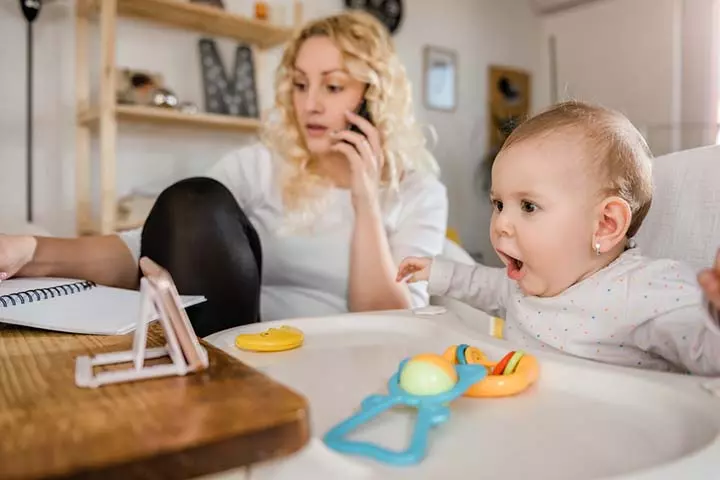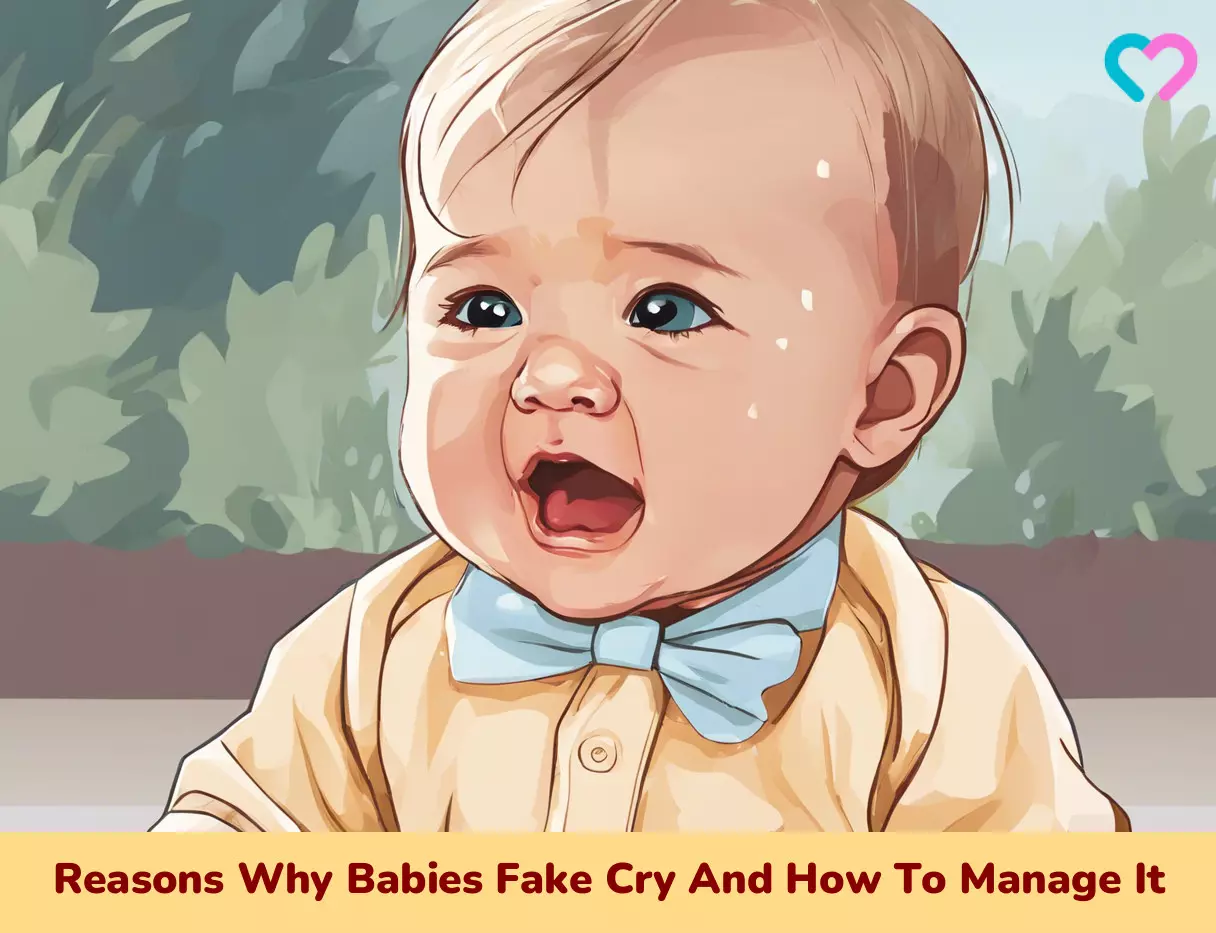
Image: Shutterstock
A baby’s fake crying can be defined as crying without vital needs. Crying is a form of communication to express pain, hunger, tiredness, and sleep. Some babies may cry without obvious reasons or for parents’ or caregivers’ attention. You may notice random fake crying in your baby without reasons or for specific purposes such as to hold them in your arms or soothe them. Although many parents may worry about why their baby is crying, eventually, most of them figure out the reasons. Understanding the nuances of fake crying is essential for parents, as it helps differentiate between genuine needs and the baby’s attempts at communication. This knowledge fosters a stronger bond between the parent and child, promoting a nurturing environment. Read on to learn more about reasons and how to handle a baby’s fake crying.
Key Pointers
- If a baby cries without any apparent vital need such as food, sleep, or pain, it can be called a fake cry.
- A baby may fake a crying episode to attract attention or express displeasure.
- You can try distracting the baby by speaking to them, changing your response, and at times, ignoring them.
What Is Fake Crying?
A baby’s fake crying could be defined as crying that is not motivated by vital needs, such as food, sleep, change of diapers, and caregivers’ attention to pain. Infants who fake their crying are also not any discomfort due to illness, injury, or emotional issues, such as fear.
Fake crying in babies can be tricky to identify, but a few signs can help differentiate fake crying from real distress. A baby fake crying may:
- Stop crying suddenly to check for the reaction.
- Take a pause mid-cry and smile as soon as someone comes.
- Cry louder but without tears, and crying may have high-pitched sounds.
- Crawl closer to the parent to make their crying noticeable.
- Instantly stop crying when distracted using a toy, cuddle, or a change in environment.
- Show exaggerated expressions when crying, like pouting.
Cry without any triggers even when all their needs have been met. It usually suggests that the baby is aware that their behavior will lead to some reaction from their parents or primary caregivers.
At What Age Do Babies Start Fake Crying?
There is no specific age when a baby may begin fake crying. Babies usually learn several new communication skills between the ages of six and 12 months (1). Therefore, a baby may display more episodes of fake crying between the ages of six and 12 months.
Why Do Babies Fake Cry?
Usually, a baby fakes crying only when they know it is likely to be heard by a caregiver. Below are the reasons why babies may fake their crying.
1. Gain attention

The most common reason behind a baby’s fake crying or simulated whimpering is to attract the attention of a parent or caregiver (2). Babies enjoy the company of parents and other primary caregivers. So, if the baby cries when a parent is not around, it indicates they want their attention. It is the baby’s way to elicit their parent’s company. In such cases, the baby usually becomes cheerful once the parent is close and starts crying the moment the parent leaves.
A study noted that babies displayed a positive emotional state before certain types of crying not associated with distress (3). It suggested that the babies in the study were crying voluntarily and, thus, were fake crying. The researchers noted that it was a remarkable way to gain parents’ attention, and babies who fake cry may have better communication skills in the long run.
2. Experiment with cause and effect
Babies experiment with cause and effect from an early age, and one of the first effects they observe is the parents’ reaction to their crying. A baby from the age of four months may have a different type of cry to communicate specific emotions, such as hunger or pain (4). As they grow older, they are likely to use the skill for experimentation.
The little one may cry to play with cause and effect and observe various possible reactions (5). You may even notice different types of fake crying, depending on the situation and your previous responses to your baby’s artificial weeping.
3. Express displeasure
Fake crying could also be used to communicate displeasure to a situation or an event. For instance, a baby may fake cry with sniffles (counterfeit sniveling) to communicate displeasure when a play session ends or when you reach the end of a book (4). Fake crying to express displeasure is usually easily discernible since it begins at the end of an interesting activity and stops the moment an activity is restarted.
Sandy Philpott, a mother and blogger, shares how her son expresses displeasure. She says, “I really thought I wouldn’t have to deal with whining until Ryan was able to talk. Ha! Rookie mistake. Since yesterday afternoon, he’s been cantakerous and unhappy, and he’s been expressing his displeasure by whining. Unlike a whining toddler, who can at least express what it is he’s whining about (“No nap, Mommy! Nooooo naaaaaaaap!!!!”), all I get is a pathetic moan that sounds like it should be accompanied by a dramatic hand to the head and a collapse onto a fainting couch. (i).”
4. Throw a tantrum

Tantrums could also be the reason behind fake crying, especially among toddlers. One of the common types of tantrums is a temper tantrum, which is often displayed by a toddler when their desires are not fulfilled immediately (6). For example, a toddler’s loud crying when not allowed to use a phone or taken away from their favorite park.
 Point to consider
Point to considerFake crying during a tantrum is similar to feigned wailing to express displeasure. However, tantrums tend to be more common among toddlers older than 12 months and are accompanied by other signs of emotional outbursts, such as screaming, insincere bawling, and hitting an object or person (7).
Is Fake Crying Bad?

Fake crying is usually not considered a bad or problematic behavioral attribute. Parents need to recognize that this behavior is a normal part of emotional development and does not indicate any underlying issues unless it persists beyond typical developmental stages. It is common for babies to fake cry to gain attention and seek parents’ company. Older babies and toddlers commonly fake cry to experiment with the reaction they receive. Fake crying due to tantrums can be managed by observing the triggers and types of tantrums, such as tantrums before bedtime. As the baby grows older, they learn to use simple words and sentences to communicate emotions rather than fake crying.
How To Stop Fake Crying In Babies?
There is usually no need to stop fake crying since it stops as the baby grows older. However, if there is a developmental concern, talk to your pediatrician to make sure it is normal behavior. You may try the following ways to manage it until the baby is old enough to communicate through speech.
- Distract the baby: Distraction works great for babies who fake cry to express displeasure. For instance, if the baby is fake crying because a game or activity has ended, you may immediately distract them with a toy, sound, or by talking to them.

- Change responses: If you lift the baby and cuddle each time they fake their crying, your response becomes predictable. Change the way you respond to discourage fake crying. Instead of lifting the baby, you may let them stay in the crib while you sit nearby. Provide them with a toy or say “No” as an alternative response. When you display unpredictable responses, a baby is less likely to play with fake crying to test its effects and gain attention for non-essential reasons.
According to the American Academy of Pediatrics (AAP), “Playing, talking, singing, rocking and walking may help. Simply repositioning them or letting them fuss it out may also be a successful strategy. You might also find that while a particular response works momentarily, they’ll soon become even fussier and demand more attention. This cycle may continue until you either let them cry a few minutes or distract them with something different—for example, taking them outside (8).”
 Quick tip
Quick tip- Speak to the baby: Babies learn to respond to sounds by making sounds at six months and can understand “No” by nine months. Encourage the baby to use simple sounds and words to communicate their emotions instead of fake crying. One of the best ways to do it is to strike a conversation with the baby the moment you sense they are faking their crying. Ask the baby, “What do you want?” or “May I do something for you?”. You may also give simple names to objects, such as “boo” for a book or “aay” for a toy to stimulate the use of speech. Point at the named objects and talk, and the next time the baby may do the same instead of fake crying.

- Set simple rules: Fake crying due to tantrums among toddlers could be regulated by setting defined limits and rules. You may set rules for various daily activities, such as a time limit for play. You may also set a daily schedule to help make the routine predictable for the toddler. If the toddler shows adherence to rules and reduces fake crying, appreciate them to reinforce the good behavior (9).
- Ignoring: It may seem challenging, but if you know your baby is changed, fed, in good health, etc., it is ok to step away from the situation as long as the baby is in a safe space. Learning to say ”no,” is a vital part of parenting and will be beneficial in the long run, especially in cases of bogus lamenting.
According to Noah Schwartz, a pediatrician at the Cleveland Clinic, “The most important thing is to stay calm. It’s OK to put your baby down in a safe place and take a few minutes to catch your breath. With a cooler head, you’ll be better able to figure out what they’re trying to tell you (10).”
Frequently Asked Questions
1. How can I help my baby learn to express their emotions without fake crying?
Be attentive to your baby’s nonverbal cues and encourage verbal or gestural expression. If your baby is old enough to make sounds or say a syllable, encourage them to use it to express their needs. Ask questions to your child. Even if they do not understand the meaning, they will sense its intent by the tone of your voice.
2. How can I create a nurturing environment that discourages fake crying?
To foster a nurturing environment and discourage pretend sobbing, attend and respond to nonverbal cues, encourage verbal or gestural communication, validate emotions, provide safety and support, avoid rewards, and be consistent and patient.
Your baby fake crying may mean they want care and company. Babies may resort to fake crying to gain attention, experiment with their actions and consequences, or throw a tantrum. These are normal infant responses and are generally not a cause for concern. The behavior usually resolves as the baby grows and learns to communicate through speech. Changing your responses to their phony tears, distracting them, or teaching them other ways to communicate will help reduce this habit in babies. Nevertheless, you may consult a pediatrician if you sense your baby’s fake crying happens frequently or has an increased intensity of late.
Infographic: Ways To Manage Your Infant’s Cries With No Cause
Witnessing a baby cry is often not a favorable sight. Although babies cry for myriad reasons, at times, it is difficult to comprehend the cause of their cries. We bring you some helpful tips in this infographic to help deal with such a situation. Illustration: Momjunction Design Team
Illustration: Reasons Why Babies Fake Cry And How To Manage It

Image: Stable Diffusion/MomJunction Design Team
Personal Experience: Source
MomJunction articles include first-hand experiences to provide you with better insights through real-life narratives. Here are the sources of personal accounts referenced in this article.
i. Would You Like Some Cheese With That Whine?https://sandysmotherhoodblog.blogspot.com/2010/03/would-you-like-some-cheese-with-that.html
References
- Milestone Moments; CDC
- R. Gatrad and Aziz Sheikh; (2004); Persistent crying in babies; U.S. National Library of Medicine
- Hiroko Nakayama; (2013) Changes in the affect of infants before and after episodes of crying; U.S. National Library of Medicine
- Important Milestones: Your Baby By Four Months; CDC
- Play; U.S. Department of Health & Human Services
- Temper tantrums; U.S. National Library of Medicine
- Emotional Development: 2 Year Olds; American Academy of Pediatrics
- Emotional & Social Development in Babies: Birth to 3 Months; American Academy of Pediatrics
- What’s the Best Way to Discipline My Child?; American Academy of Pediatrics
- Why Is Your Baby Crying?; Cleveland Clinic
Community Experiences
Join the conversation and become a part of our nurturing community! Share your stories, experiences, and insights to connect with fellow parents.
Read full bio of Dr. Tashawna Stokes
Read full bio of Rohit Garoo
Read full bio of Dr. Ritika Shah
Read full bio of Ghazia Shah

















